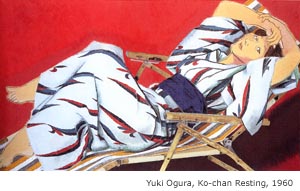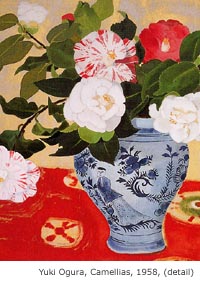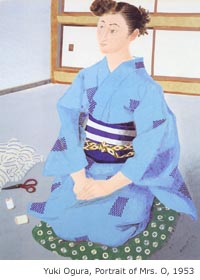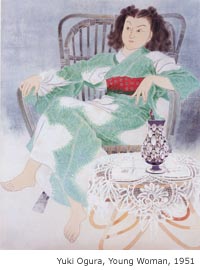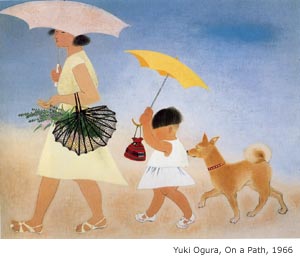
"Something bright,
warm and funÉthe joy of being alive." This was the feeling Yuki Ogura
wanted to depict in her 1966 painting, "On a Path". However, the warmth
and humanity in this and her work, which makes it endearing to audiences
also distracts from the important part her art played in finding a new
path for Japanese art in the twentieth century. An extensive exhibition
of her work at the Museum of Modern Art captures Yuki Oguras artistic
achievement from a long and productive career. Ogura transformed both
subject and composition in Nihonga (Japanese traditional style painting)
while maintaining a strong sense of tradition in method and philosophy.
Women, children, vases and flowers form the core subjects of Yuki Ogura.
Born in 1895 she began exhibiting her painting in 1929/. Ogura exhibited
her first work with the Inten (the official Japanese traditional art academy)
in 1926. Before this, she had received extensive training in painting
and poetry at a womens High School in Nara. She had also begun a lifelong
association with master artist Yukihiko Yasuda. Painting right up to the
year of her death, at age 105, Oguras career has spanned an epoch of
rapid change.
"Women bathing", painted by Ogura in 1938, was a pivotal work. In size,
composition and technique it reveals a marked departure from the traditional
style of Japanese painting. In this work, Ogura has abandoned many rules
and formulas of traditional painting in favor of direct observation and
a more scientific approach. This is reflected in her depiction of the
bath tiles through the translucent green water. The tile joint-lines wave
and curve through the optical effects of the waters refractive lens.
Ogura draws the naked young women luxuriating in the warm bath in a gently
abstracted simplified line and form. Yet, in contrast to their bodies,
their dark black hair is delicately detailed. While this work departs
from many traditions it does not abandon al elements of Nihonga style.
Her painting post war reveals another turn in style towards modernism.
Three works, "Young Woman", 1951, "Portrait of Mrs. O" 1953 and "Ko-chan
Resting", 1960 depict this change but also the dramatic changes in societal
values that swept Japanese society. The strong gaze of the paintings women
reflect changes in social status that had began during the war years.
Oguras post war compositions have dramatic diagonals with bold colors
and patterns. Many of these new elements in her art can be attributed
to her study and observation of the work of the European modernist painters
Henri Matisse and Pablo Picasso.
Yuki Ogura has a special talent for painting camellias. She painted many
works depicting vases of flowers and blossoms, but her depictions of camellias
seem particularly sensitive. The strong solid color and patterns in the
background to these still lives is a reminder of her modernist ideas and
the strong influence of Matisse on her work.
Yuki Ogura is among a small group of Japanese artists that helped maintain
the Nihonga tradition of painting through the modernization of Japan.
She did this by being both innovator and conservator. Her modern styled
compositions and subjects at the end of the second world war saved Nihonga
style art from being discarded along with a range of other 'old world
traditions associated with a defeated culture. However, Ogura maintained
many of the traditional techniques of paper, pigment and free flowing
line. As a woman artist, she also marks a departure from tradition. She
represented as well as depicted a new era for Japanese women, which is
still slowly unfolding.
